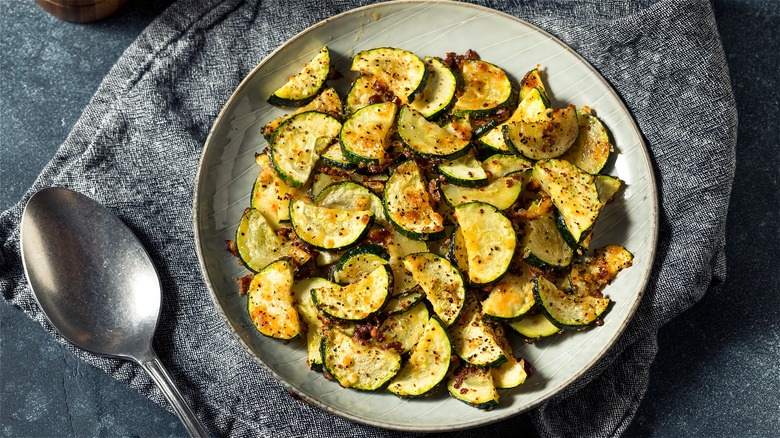Never Eat Soggy Roasted Zucchini Again With This Simple Tip
If you try your best to avoid the consumption of soggy vegetables, you may side-step zucchini as a veritable side dish. Yet, beyond making a few loaves of classic zucchini bread, enjoying this nutritious veggie solo without worrying about its resulting texture on your plate is essential. Fortunately, with the help of strategic chopping and a few other preparation tips, you're well on your way to enjoying cooked zucchini that holds a firmer, more satisfying bite.
Zucchini is popular and easy to eat due to its mild, versatile flavor. Even though this oblong squash is over 90% water, zucchini is loaded with several important vitamins and minerals like vitamin A, manganese, and potassium. While you may have become accustomed to finding creative ways to incorporate this veggie into different casseroles and pasta dishes, you can enjoy simple zucchini roasted with mindful preparation.
Instead of cutting squash into bite-sized chunks, chop larger pieces. If you want to cut zucchini into rounds, slice discs thicker than usual. Smaller, thinner pieces have a higher chance of overcooking and potentially burning along the edges. Luckily, with a few different preparation methods, you can retain zucchini's firm consistency throughout the cooking process.
How to ensure your roasted zucchini has a desirable texture every time
Beyond chopping your zucchini into larger chunks, you can also prepare this versatile veggie creatively, which might spur some new recipe inspiration. Next to thicker pieces, try cutting whole zucchinis into quarter segments. Cut the ends off each zucchini and holding upright, cut down vertically into four equally shaped pieces. The result will resemble pickle spears. From here, add your seasoning of choice and roast.
Alternatively, to pair zucchini with a more substantial topping, slice whole squash in half and scoop a small well within each side. Fill halves or zucchini boats with any topping you desire. Some tasty options include finely chopped veggies, rice, tomato sauce, herb-kissed breadcrumbs, cooked sausage, and cheese. To ensure these thicker portions of zucchini are evenly roasted, roast boats without filling cut-side down in your baking pan for half the cooking time. After flipping, fill and finish baking until zucchini reaches roasted perfection.
Whichever way you prepare this versatile squash, add a wire rack to your baking pan before roasting to give zucchini a supreme texture when cooked. Keeping cut zucchini raised throughout the cooking process helps roast prepared vegetables evenly on all sides, warding off the potential for soggy or extra-moist portions.
More clever ways to prepare perfectly roasted zucchini
Before sticking zucchini in the oven, follow a few additional tips to ensure your roasted zucchini reaches a desirable consistency every time. Once raw zucchini has been chopped, add salt and allow the pieces to drain in a colander in your sink for roughly 30 minutes. Use a paper towel to remove any extra liquid. Salt helps remove zucchini's excess moisture which helps keep veggies nice and firm come meal time.
Next, make sure to give your zucchini portions ample cooking space. Overcrowded baking pans may cause zucchini to steam, which may indirectly increase the production of excess liquid. Besides ensuring zucchini has enough room on your baking sheet, always allow your oven to preheat and roast zucchini at a high temperature. Zucchini cooked between 400 and 450 degrees Fahrenheit cooks faster and evaporates excess moisture in a flash. Besides the shortened cooking time, your veggies will be left with some color thanks to the Maillard reaction or reactive browning that occurs when proteins and sugar come together under high heat conditions.
Most importantly, follow the hack that gives you perfectly roasted veggies every time. Keep a close eye on your zucchini when roasting and stop cooking when the veggies are sufficiently cooked yet still maintain a bit of firmness. Beyond keeping these useful tips at the forefront, cutting zucchini into larger segments lessens your chance of creating a soggy side dish.


